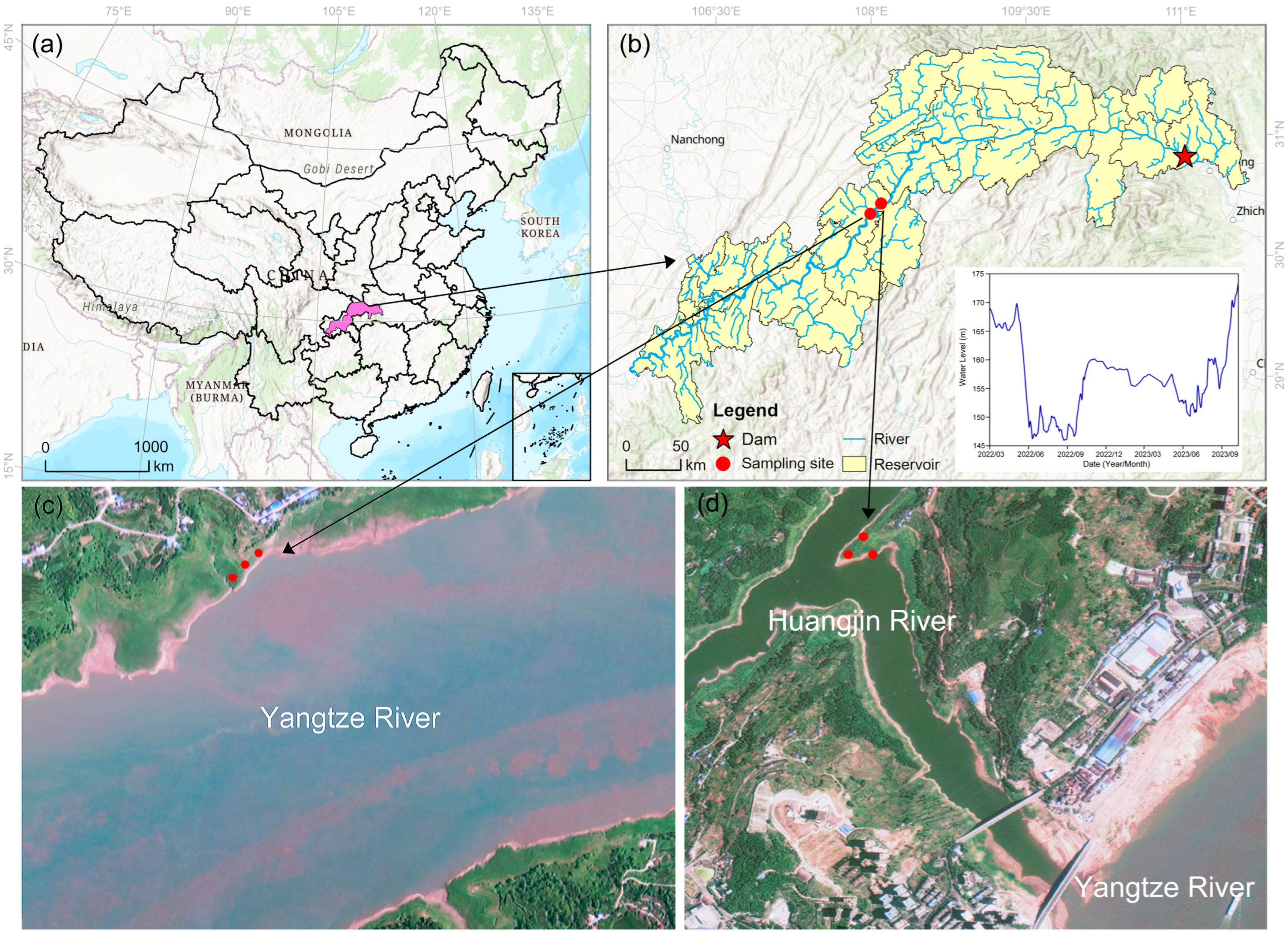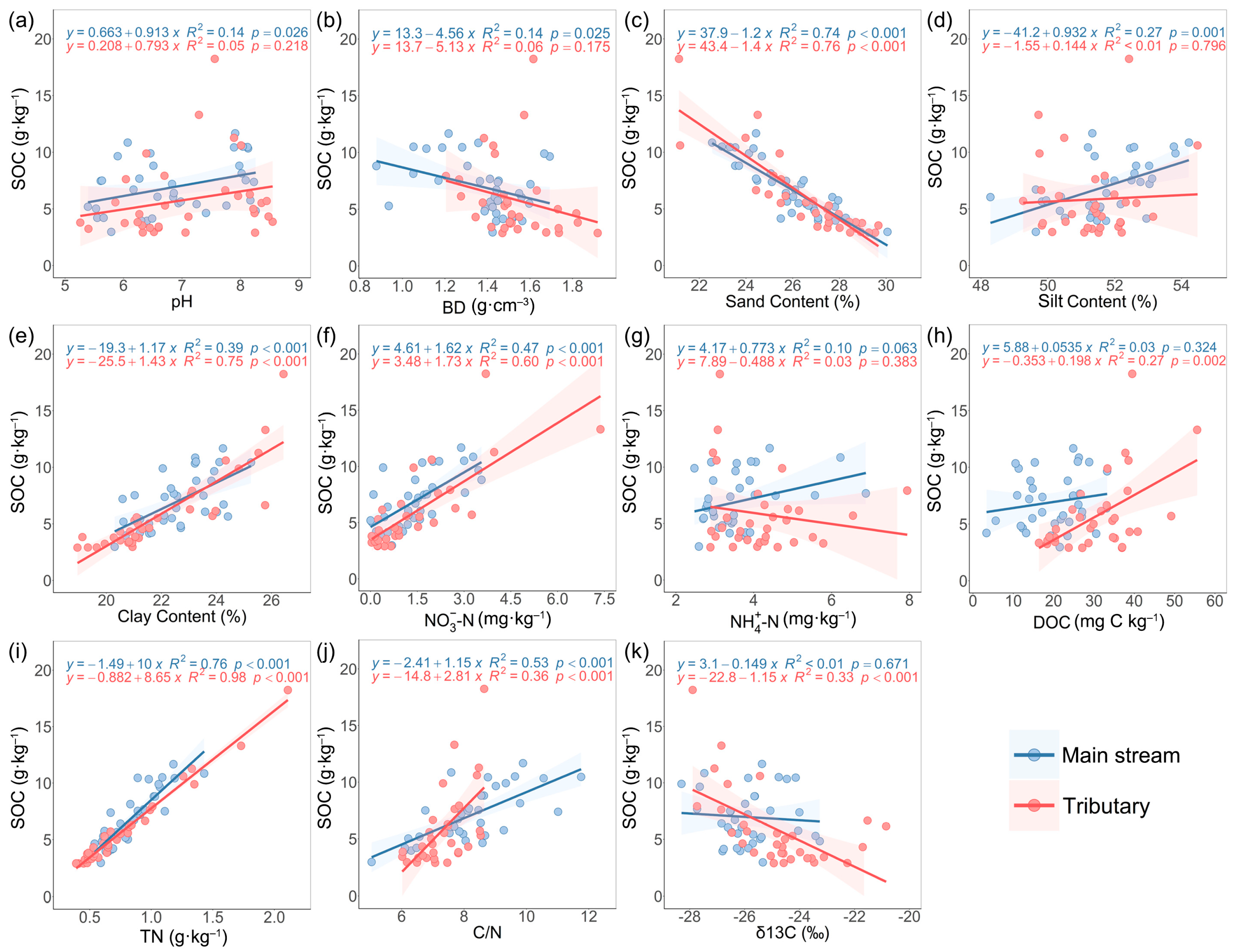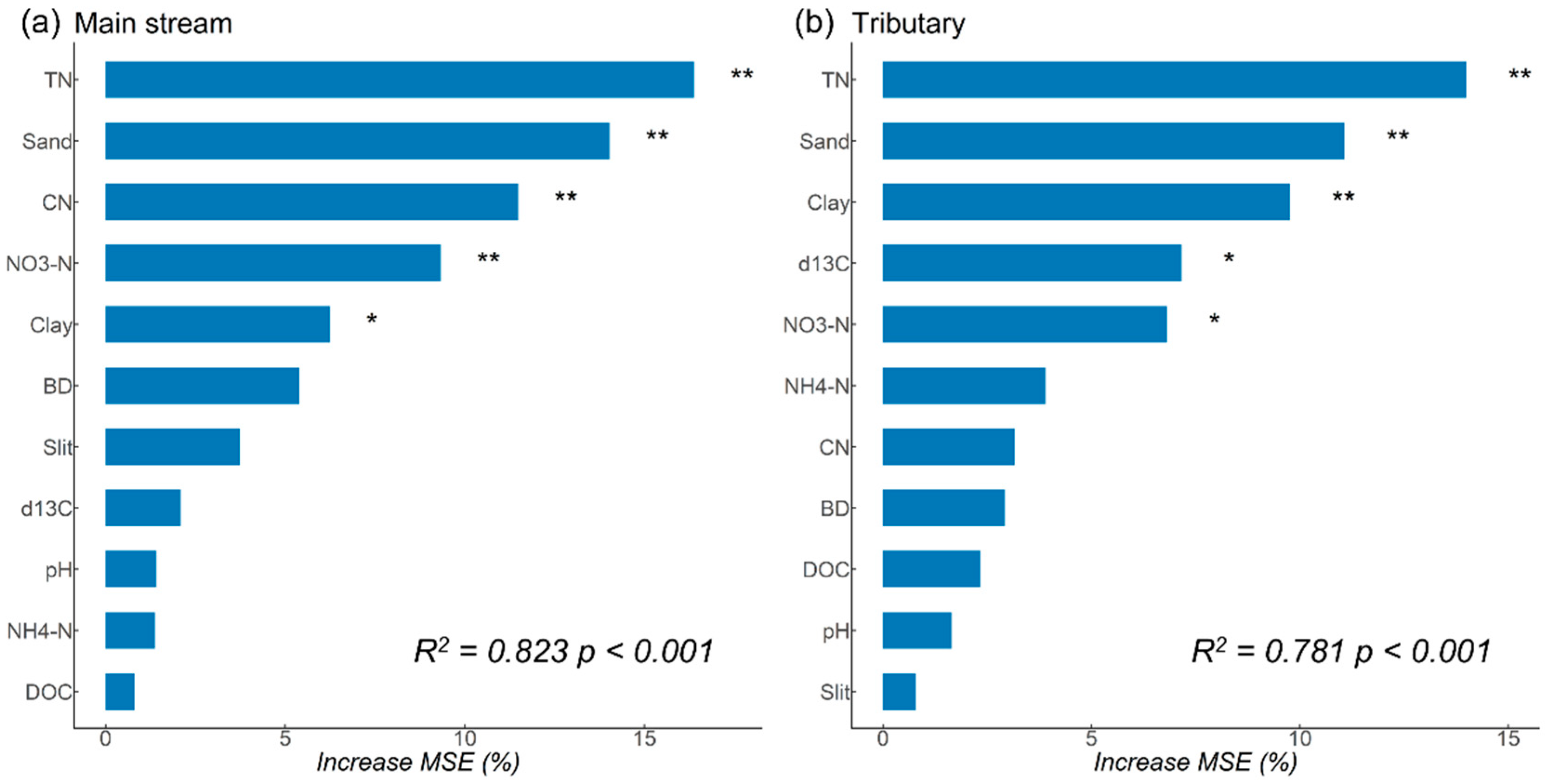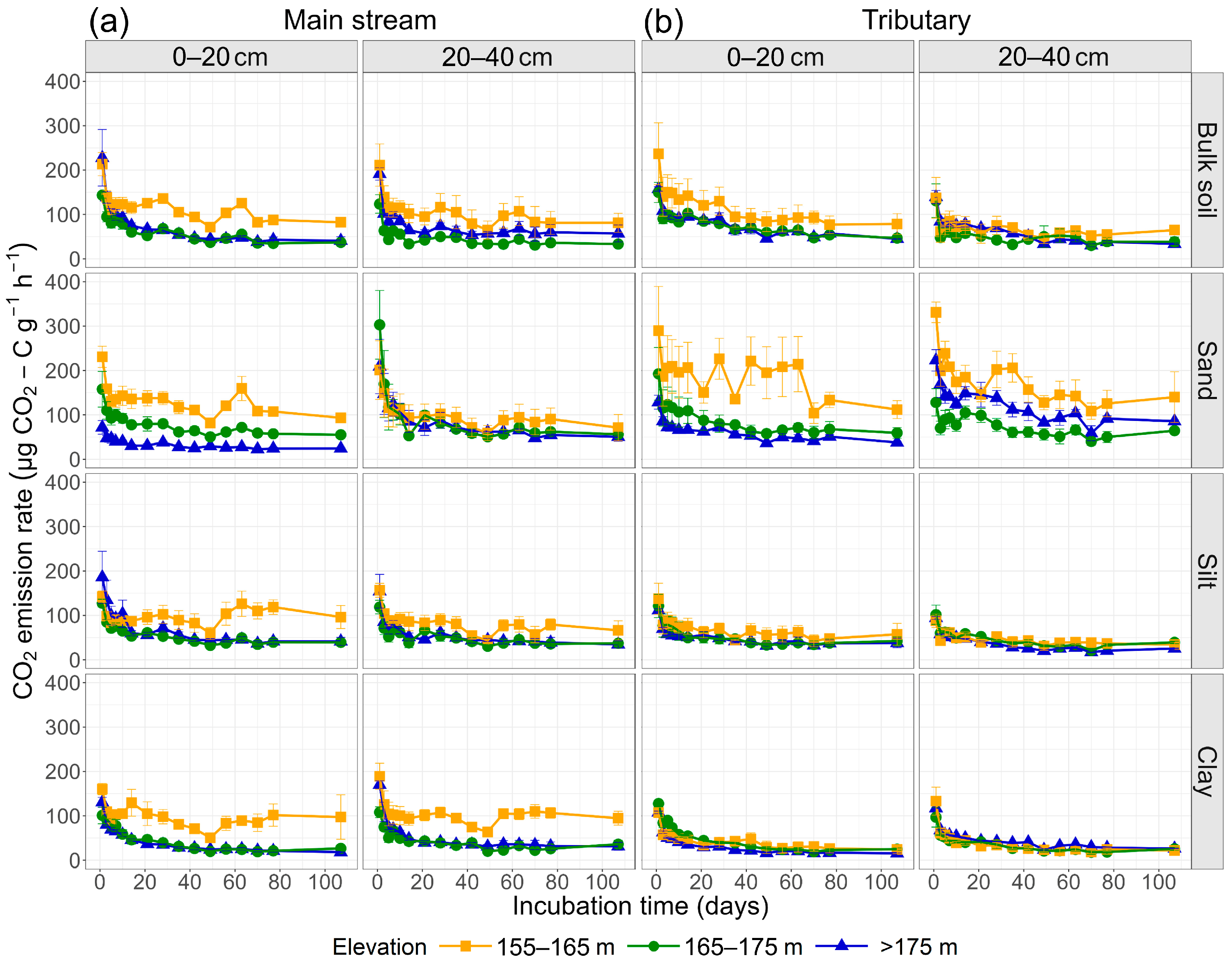Hydrological Control of SOC Dynamics via Particle Size Redistribution Along Elevation Gradients in the Water Level Fluctuation Zone of the Three Gorges Reservoir
Abstract
1. Introduction
2. Materials and Methods
2.1. Experiment Site
2.2. Soil Sampling and Physicochemical Analyses
2.3. Incubation Experiment
2.4. Data Processing and Statistical Methods
3. Results
3.1. SOC Content and Stock
3.2. Main Controls on the SOC
3.3. Mineralization Dynamics of Different Soil Particle Size Fractions
4. Discussion
4.1. Elevation-Dependent Soil Organic Carbon Dynamics
4.2. Differences in Carbon Stability Among Particle Size Fractions
4.3. Management Implications
4.4. Limitations
5. Conclusions
Author Contributions
Funding
Data Availability Statement
Conflicts of Interest
References
- Zhao, Y.; Lin, J.; Cheng, S.; Wang, K.; Kumar, A.; Yu, Z.-G.; Zhu, B. Linking Soil Dissolved Organic Matter Characteristics and the Temperature Sensitivity of Soil Organic Carbon Decomposition in the Riparian Zone of the Three Gorges Reservoir. Ecol. Indic. 2023, 154, 110768. [Google Scholar] [CrossRef]
- Yu, Z.; Kumar, A.; Zhang, S.; Yu, Z.-G.; Shan, S.; Zhu, B.; Lin, J. Thermal Sensitivity of Soil Organic Carbon Decomposition in Riparian Ecosystems. Plant Soil 2024, 1–15. [Google Scholar] [CrossRef]
- Ye, C.; Li, S.; Zhang, Y.; Tong, X.; Zhang, Q. Assessing Heavy Metal Pollution in the Water Level Fluctuation Zone of China’s Three Gorges Reservoir Using Geochemical and Soil Microbial Approaches. Environ. Monit. Assess. 2013, 185, 231–240. [Google Scholar] [CrossRef] [PubMed]
- Miao, C.; Borthwick, A.; Liu, H.; Liu, J. China’s Policy on Dams at the Crossroads: Removal or Further Construction? Water 2015, 7, 2349–2357. [Google Scholar] [CrossRef]
- Bai, Q.; Bao, Y.; Yu, Y.; Yang, J.; Wang, Y.; Wei, J. Effects of Different Vegetation Restoration Models on Soil Nutrients in the Water Level Fluctuation Zone of a Large Reservoir. Ecol. Indic. 2024, 169, 112955. [Google Scholar] [CrossRef]
- Zhu, K.; Li, W.; Yang, S.; Ran, Y.; Lei, X.; Ma, M.; Wu, S.; Huang, P. Intense Wet-Dry Cycles Weakened the Carbon Sequestration of Soil Aggregates in the Riparian Zone. CATENA 2022, 212, 106117. [Google Scholar] [CrossRef]
- Wei, C.; Qiu, Y.; Chi, Y.; Li, Y.; Yi, W.; Zhou, Y.; Yan, C. The Patterns and Controlling Factors of Soil Carbon and Nitrogen in the Water Level Fluctuation Zone of the Three Gorges Reservoir. J. Soils Sediments 2024, 25, 179–194. [Google Scholar] [CrossRef]
- Wang, H.; Gao, D.; Hu, G.; Xu, W.; Zhuge, Y.; Bai, E. Drying-Rewetting Events Enhance the Priming Effect on Soil Organic Matter Mineralization by Maize Straw Addition. CATENA 2024, 238, 107872. [Google Scholar] [CrossRef]
- Ye, C.; Butler, O.M.; Chen, C.; Liu, W.; Du, M.; Zhang, Q. Shifts in Characteristics of the Plant-Soil System Associated with Flooding and Revegetation in the Riparian Zone of Three Gorges Reservoir, China. Geoderma 2020, 361, 114015. [Google Scholar] [CrossRef]
- Shi, W.; Du, M.; Ye, C.; Zhang, Q. Divergent Effects of Hydrological Alteration and Nutrient Addition on Greenhouse Gas Emissions in the Water Level Fluctuation Zone of the Three Gorges Reservoir, China. Water Res. 2021, 201, 117308. [Google Scholar] [CrossRef]
- Zhu, K.; Ma, M.; Ran, Y.; Liu, Z.; Wu, S.; Huang, P. In Mitigating CO2 Emission in the Reservoir Riparian: The Influences of Land Use and the Dam-Triggered Flooding on Soil Respiration. Soil Tillage Res. 2020, 197, 104522. [Google Scholar] [CrossRef]
- Liu, F.; Ding, Y.; Liu, J.; Latif, J.; Qin, J.; Tian, S.; Sun, S.; Guan, B.; Zhu, K.; Jia, H. The Effect of Redox Fluctuation on Carbon Mineralization in Riparian Soil: An Analysis of the Hotspot Zone of Reactive Oxygen Species Production. Water Res. 2024, 265, 122294. [Google Scholar] [CrossRef] [PubMed]
- Ye, C.; Zhang, K.; Deng, Q.; Zhang, Q. Plant Communities in Relation to flooding and Soil Characteristics in the Water Level Fluctuation Zone of the Three Gorges Reservoir, China. Environ. Sci. Pollut. Res. 2013, 20, 1794–1802. [Google Scholar] [CrossRef]
- Wang, Y.; Liu, Y.; Ma, M.; Ding, Z.; Wu, S.; Jia, W.; Chen, Q.; Yi, X.; Zhang, J.; Li, X.; et al. Dam-Induced Difference of Invasive Plant Species Distribution along the Riparian Habitats. Sci. Total Environ. 2022, 808, 152103. [Google Scholar] [CrossRef]
- Khurram, D.; Tang, Q.; Bao, Y.; He, X.; Li, J. Flow Regulation Controls Sediment, Carbon, and Nutrient Dynamics across the Elevation Gradient in the Water Level Fluctuation Zone of the Three Gorges Reservoir, China. J. Soils Sediments 2023, 23, 3201–3218. [Google Scholar] [CrossRef]
- Ran, Y.; Wu, S.; Jiang, Y.; Qu, J.; Kaushalya Herath, I.; Huang, P. The Legacy Effects of Soil Types on Carbon Content Are Erased by Extreme Flooding Stress in a Water-Level Drawdown Zone. CATENA 2023, 231, 107283. [Google Scholar] [CrossRef]
- Teng, M.; Zeng, L.; Xiao, W.; Huang, Z.; Zhou, Z.; Yan, Z.; Wang, P. Spatial Variability of Soil Organic Carbon in Three Gorges Reservoir Area, China. Sci. Total Environ. 2017, 599–600, 1308–1316. [Google Scholar] [CrossRef] [PubMed]
- Li, D.; Niu, S.; Luo, Y. Global Patterns of the Dynamics of Soil Carbon and Nitrogen Stocks Following Afforestation: A Meta-analysis. New Phytol. 2012, 195, 172–181. [Google Scholar] [CrossRef]
- Ran, Y.; Wu, S.; Zhu, K.; Li, W.; Liu, Z.; Huang, P. Soil Types Differentiated Their Responses of Aggregate Stability to Hydrological Stresses at the Riparian Zones of the Three Gorges Reservoir. J. Soils Sediments 2020, 20, 951–962. [Google Scholar] [CrossRef]
- Von Lützow, M.; Kögel-Knabner, I.; Ekschmitt, K.; Flessa, H.; Guggenberger, G.; Matzner, E.; Marschner, B. SOM Fractionation Methods: Relevance to Functional Pools and to Stabilization Mechanisms. Soil Biol. Biochem. 2007, 39, 2183–2207. [Google Scholar] [CrossRef]
- Ding, F.; Sun, W.; Huang, Y.; Hu, X. Larger Q10 of Carbon Decomposition in Finer Soil Particles Does Not Bring Long-lasting Dependence of Q10 on Soil Texture. Eur. J. Soil Sci. 2018, 69, 336–347. [Google Scholar] [CrossRef]
- Craine, J.M.; Morrow, C.; Fierer, N. Microbial Nitrogen Limitation Increases Decomposition. Ecology 2007, 88, 2105–2113. [Google Scholar] [CrossRef] [PubMed]
- Bimüller, C.; Mueller, C.W.; Von Lützow, M.; Kreyling, O.; Kölbl, A.; Haug, S.; Schloter, M.; Kögel-Knabner, I. Decoupled Carbon and Nitrogen Mineralization in Soil Particle Size Fractions of a Forest Topsoil. Soil Biol. Biochem. 2014, 78, 263–273. [Google Scholar] [CrossRef]
- Tang, Q.; Collins, A.L.; Wen, A.; He, X.; Bao, Y.; Yan, D.; Long, Y.; Zhang, Y. Particle Size Differentiation Explains Flow Regulation Controls on Sediment Sorting in the Water-Level Fluctuation Zone of the Three Gorges Reservoir, China. Sci. Total Environ. 2018, 633, 1114–1125. [Google Scholar] [CrossRef]
- Wang, Y.; Chen, F.; Zhang, M.; Chen, S.; Tan, X.; Liu, M.; Hu, Z. The Effects of the Reverse Seasonal Flooding on Soil Texture within the Hydro-Fluctuation Belt in the Three Gorges Reservoir, China. J. Soils Sediments 2018, 18, 109–115. [Google Scholar] [CrossRef]
- Swanston, C.W.; Caldwell, B.A.; Homann, P.S.; Ganio, L.; Sollins, P. Carbon Dynamics during a Long-Term Incubation of Separate and Recombined Density Fractions from Seven Forest Soils. Soil Biol. Biochem. 2002, 34, 1121–1130. [Google Scholar] [CrossRef]
- Mueller, C.W.; Gutsch, M.; Kothieringer, K.; Leifeld, J.; Rethemeyer, J.; Brueggemann, N.; Kögel-Knabner, I. Bioavailability and Isotopic Composition of CO2 Released from Incubated Soil Organic Matter Fractions. Soil Biol. Biochem. 2014, 69, 168–178. [Google Scholar] [CrossRef]
- Willison, J.H.M.; Li, R.; Yuan, X. Conservation and Ecofriendly Utilization of Wetlands Associated with the Three Gorges Reservoir. Environ. Sci. Pollut. Res. 2013, 20, 6907–6916. [Google Scholar] [CrossRef]
- New, T.; Xie, Z. Impacts of Large Dams on Riparian Vegetation: Applying Global Experience to the Case of China’s Three Gorges Dam. Biodivers. Conserv. 2008, 17, 3149–3163. [Google Scholar] [CrossRef]
- Christensen, B.T. Decomposability of Organic Matter in Particle Size Fractions from Field Soils with Straw Incorporation. Soil Biol. Biochem. 1987, 19, 429–435. [Google Scholar] [CrossRef]
- Ding, F.; Sun, W.; Huang, Y. Net N2O Production from Soil Particle Size Fractions and Its Response to Changing Temperature. Sci. Total Environ. 2019, 650, 97–104. [Google Scholar] [CrossRef] [PubMed]
- Rodríguez Martín, J.A.; Álvaro-Fuentes, J.; Gonzalo, J.; Gil, C.; Ramos-Miras, J.J.; Grau Corbí, J.M.; Boluda, R. Assessment of the Soil Organic Carbon Stock in Spain. Geoderma 2016, 264, 117–125. [Google Scholar] [CrossRef]
- Zhang, Y.; Song, C.; Wang, X.; Chen, N.; Zhang, H.; Du, Y.; Zhang, Z.; Zhu, X. Warming Effects on the Flux of CH4 from Peatland Mesocosms Are Regulated by Plant Species Composition: Richness and Functional Types. Sci. Total Environ. 2022, 806, 150831. [Google Scholar] [CrossRef]
- Su, X.; Nilsson, C.; Pilotto, F.; Liu, S.; Shi, S.; Zeng, B. Soil Erosion and Deposition in the New Shorelines of the Three Gorges Reservoir. Sci. Total Environ. 2017, 599–600, 1485–1492. [Google Scholar] [CrossRef] [PubMed]
- Nsabimana, G.; Hong, L.; Yuhai, B.; De Dieu Nambajimana, J.; Jinlin, L.; Ntacyabukura, T.; Xiubin, H. Soil Aggregate Disintegration Effects on Soil Erodibility in the Water Level Fluctuation Zone of the Three Gorges Reservoir, China. Environ. Res. 2023, 217, 114928. [Google Scholar] [CrossRef]
- Iqbal, J.; Hu, R.; Feng, M.; Lin, S.; Malghani, S.; Ali, I.M. Microbial Biomass, and Dissolved Organic Carbon and Nitrogen Strongly Affect Soil Respiration in Different Land Uses: A Case Study at Three Gorges Reservoir Area, South China. Agric. Ecosyst. Environ. 2010, 137, 294–307. [Google Scholar] [CrossRef]
- Wang, X.; Li, Y.; Duan, Y.; Wang, L.; Niu, Y.; Li, X.; Yan, M. Spatial Variability of Soil Organic Carbon and Total Nitrogen in Desert Steppes of China’s Hexi Corridor. Front. Environ. Sci. 2021, 9, 761313. [Google Scholar] [CrossRef]
- Song, R.; Han, X.; Yang, Q.; Zheng, Z.; Xi, D. Effects of Understory Vegetation Heterogeneity on Soil Organic Carbon Components in Cunninghamia Lanceolata Plantation. Land 2022, 11, 2300. [Google Scholar] [CrossRef]
- Yao, Y.; Dai, Q.; Gao, R.; Yi, X.; Wang, Y.; Hu, Z. Characteristics and Factors Influencing Soil Organic Carbon Composition by Vegetation Type in Spoil Heaps. Front. Plant Sci. 2023, 14, 1240217. [Google Scholar] [CrossRef]
- Bao, Y.; Tang, Q.; He, X.; Hu, Y.; Zhang, X. Soil Erosion in the Riparian Zone of the Three Gorges Reservoir, China. Hydrol. Res. 2015, 46, 212–221. [Google Scholar] [CrossRef]
- Zhang, S.; Tang, Q.; Bao, Y.; He, X.; Tian, F.; Lü, F.; Wang, M.; Anjum, R. Effects of Seasonal Water-Level Fluctuation on Soil Pore Structure in the Three Gorges Reservoir, China. J. Mt. Sci. 2018, 15, 2192–2206. [Google Scholar] [CrossRef]
- Nsabimana, G.; Bao, Y.; He, X.; Nambajimana, J.D.D.; Wang, M.; Yang, L.; Li, J.; Zhang, S.; Khurram, D. Impacts of Water Level Fluctuations on Soil Aggregate Stability in the Three Gorges Reservoir, China. Sustainability 2020, 12, 9107. [Google Scholar] [CrossRef]
- Chen, S.; Zhang, G.; Luo, Y.; Zhou, H.; Wang, K.; Wang, C. Soil Erodibility Indicators as Affected by Water Level Fluctuations in the Three Gorges Reservoir Area, China. CATENA 2021, 207, 105692. [Google Scholar] [CrossRef]
- Canarini, A.; Dijkstra, F.A. Dry-Rewetting Cycles Regulate Wheat Carbon Rhizodeposition, Stabilization and Nitrogen Cycling. Soil Biol. Biochem. 2015, 81, 195–203. [Google Scholar] [CrossRef]
- Bagheri Novair, S.; Mirseyed Hosseini, H.; Etesami, H.; Razavipour, T. Rice Straw and Composted Azolla Alter Carbon and Nitrogen Mineralization and Microbial Activity of a Paddy Soil under Drying–Rewetting Cycles. Appl. Soil Ecol. 2020, 154, 103638. [Google Scholar] [CrossRef]
- Nagano, H.; Atarashi-Andoh, M.; Koarashi, J. Effect of Dry-Wet Cycles on Carbon Dioxide Release from Two Different Volcanic Ash Soils in a Japanese Temperate Forest. Soil Sci. Plant Nutr. 2019, 65, 525–533. [Google Scholar] [CrossRef]
- Evans, S.; Dieckmann, U.; Franklin, O.; Kaiser, C. Synergistic Effects of Diffusion and Microbial Physiology Reproduce the Birch Effect in a Micro-Scale Model. Soil Biol. Biochem. 2016, 93, 28–37. [Google Scholar] [CrossRef]
- Ding, F.; Huang, Y.; Sun, W.; Jiang, G.; Chen, Y. Decomposition of Organic Carbon in Fine Soil Particles Is Likely More Sensitive to Warming than in Coarse Particles: An Incubation Study with Temperate Grassland and Forest Soils in Northern China. PLoS ONE 2014, 9, e95348. [Google Scholar] [CrossRef]
- Franzluebbers, A. Potential C and N Mineralization and Microbial Biomass from Intact and Increasingly Disturbed Soils of Varying Texture. Soil Biol. Biochem. 1999, 31, 1083–1090. [Google Scholar] [CrossRef]
- Ludwig, B.; John, B.; Ellerbrock, R.; Kaiser, M.; Flessa, H. Stabilization of Carbon from Maize in a Sandy Soil in a Long-term Experiment. Eur. J. Soil Sci. 2003, 54, 117–126. [Google Scholar] [CrossRef]
- Sessitsch, A.; Weilharter, A.; Gerzabek, M.H.; Kirchmann, H.; Kandeler, E. Microbial Population Structures in Soil Particle Size Fractions of a Long-Term Fertilizer Field Experiment. Appl. Environ. Microbiol. 2001, 67, 4215–4224. [Google Scholar] [CrossRef]
- Lagomarsino, A.; Grego, S.; Kandeler, E. Soil Organic Carbon Distribution Drives Microbial Activity and Functional Diversity in Particle and Aggregate-Size Fractions. Pedobiologia 2012, 55, 101–110. [Google Scholar] [CrossRef]
- Liu, Y.; Ma, M.; Ran, Y.; Yi, X.; Wu, S.; Huang, P. Disentangling the Effects of Edaphic and Vegetational Properties on Soil Aggregate Stability in Riparian Zones along a Gradient of Flooding Stress. Geoderma 2021, 385, 114883. [Google Scholar] [CrossRef]
- Xiao, Y.; Xiao, Q.; Xiong, Q.; Yang, Z. Effects of Ecological Restoration Measures on Soil Erosion Risk in the Three Gorges Reservoir Area Since the 1980s. GeoHealth 2020, 4, e2020GH000274. [Google Scholar] [CrossRef] [PubMed]
- Liu, L.; Huang, X.; Zhang, J.; Cai, Z.; Jiang, K.; Chang, Y. Deciphering the Relative Importance of Soil and Plant Traits on the Development of Rhizosphere Microbial Communities. Soil Biol. Biochem. 2020, 148, 107909. [Google Scholar] [CrossRef]
- Ye, F.; Ma, M.H.; Wu, S.J.; Jiang, Y.; Zhu, G.B.; Zhang, H.; Wang, Y. Soil Properties and Distribution in the Riparian Zone: The Effects of Fluctuations in Water and Anthropogenic Disturbances. Eur. J. Soil Sci. 2019, 70, 664–673. [Google Scholar] [CrossRef]









| Parameter | Main Stream | Tributary | ||||
|---|---|---|---|---|---|---|
| Elevation | Depth | Interaction | Elevation | Depth | Interaction | |
| pH | 0.000 *** | 0.330 | 0.343 | 0.010 * | 0.901 | 0.628 |
| BD | 0.000 *** | 0.763 | 0.836 | 0.105 | 0.024 * | 0.186 |
| Sand | 0.006 ** | 0.000 *** | 0.004 ** | 0.070 | 0.000 *** | 0.513 |
| Silt | 0.292 | 0.009 ** | 0.118 | 0.692 | 0.754 | 0.668 |
| Clay | 0.018 * | 0.182 | 0.741 | 0.003 ** | 0.000 *** | 0.254 |
| NO3−-N | 0.013 * | 0.101 | 0.747 | 0.000 *** | 0.000 *** | 0.000 *** |
| NH4+-N | 0.000 *** | 0.000 *** | 0.000 *** | 0.320 | 0.780 | 0.230 |
| DOC | 0.226 | 0.195 | 0.882 | 0.051 | 0.001 ** | 0.204 |
| TN | 0.465 | 0.000 *** | 0.516 | 0.000 *** | 0.000 *** | 0.003 ** |
| C/N | 0.000 *** | 0.041 * | 0.050 | 0.066 | 0.007 *** | 0.855 |
| δ13C | 0.000 *** | 0.003 ** | 0.742 | 0.000 *** | 0.723 | 00.177 |
| SOC | 0.000 *** | 0.000 *** | 0.116 | 0.000 *** | 0.000 *** | 0.004 ** |
| Region | Depth | Elevation | Bulk Soil | Sand | Silt | Clay |
|---|---|---|---|---|---|---|
| Main stream | 0–20 cm | >175 m | 1205.21 ± 207.13 Ab | 774.63 ± 80.98 Bb | 970.35 ± 104.45 ABb | 1172.72 ± 124.94 Ab |
| 165–175 m | 935.41 ± 23.29 Bb | 1461.68 ± 184.97 Ab | 937.47 ± 133.30 Bb | 1100.13 ± 188.90 Bb | ||
| 155–165 m | 2594.15 ± 178.99 a | 3430.33 ± 457.20 a | 2247.03 ± 505.58 a | 3488.49 ± 1015.10 a | ||
| 20–40 cm | >175 m | 936.66 ± 220.20 ab | 794.25 ± 112.45 | 661.63 ± 124.64 b | 1284.28 ± 280.75 b | |
| 165–175 m | 428.05 ± 46.76 b | 613.55 ± 83.13 | 562.17 ± 100.94 b | 786.43 ± 167.34 b | ||
| 155–165 m | 1724.39 ± 662.15 a | 1754.35 ± 737.80 | 1418.63 ± 383.94 a | 2847.38 ± 443.40 a | ||
| Tributary | 0–20 cm | >175 m | 2104.46 ± 231.29 | 1576.97 ± 252.73 | 1673.45 ± 359.58 | 1292.74 ± 19.29 |
| 165–175 m | 1332.23 ± 67.05 | 1059.88 ± 285.67 | 787.41 ± 220.52 | 1244.57 ± 168.43 | ||
| 155–165 m | 1262.59 ± 455.43 | 1993.30 ± 564.07 | 1159.35 ± 387.90 | 1292.17 ± 475.84 | ||
| 20–40 cm | >175 m | 619.35 ± 52.99 B | 690.96 ± 111.48 B | 584.16 ± 21.23 B | 1113.24 ± 8.68 A | |
| 165–175 m | 469.97 ± 129.91 | 502.46 ± 129.28 | 586.95 ± 42.79 | 828.64 ± 177.91 | ||
| 155–165 m | 542.24 ± 139.32 B | 773.62 ± 103.17 AB | 539.61 ± 107.21 B | 905.66 ± 122.79 A |
Disclaimer/Publisher’s Note: The statements, opinions and data contained in all publications are solely those of the individual author(s) and contributor(s) and not of MDPI and/or the editor(s). MDPI and/or the editor(s) disclaim responsibility for any injury to people or property resulting from any ideas, methods, instructions or products referred to in the content. |
© 2025 by the authors. Licensee MDPI, Basel, Switzerland. This article is an open access article distributed under the terms and conditions of the Creative Commons Attribution (CC BY) license (https://creativecommons.org/licenses/by/4.0/).
Share and Cite
Liu, X.; Li, Q.; Hong, D.; Dong, H.; Yang, B.; Wang, X. Hydrological Control of SOC Dynamics via Particle Size Redistribution Along Elevation Gradients in the Water Level Fluctuation Zone of the Three Gorges Reservoir. Agronomy 2025, 15, 2555. https://doi.org/10.3390/agronomy15112555
Liu X, Li Q, Hong D, Dong H, Yang B, Wang X. Hydrological Control of SOC Dynamics via Particle Size Redistribution Along Elevation Gradients in the Water Level Fluctuation Zone of the Three Gorges Reservoir. Agronomy. 2025; 15(11):2555. https://doi.org/10.3390/agronomy15112555
Chicago/Turabian StyleLiu, Xianglong, Qiuhong Li, Desheng Hong, Hongyang Dong, Bin Yang, and Xiaoguo Wang. 2025. "Hydrological Control of SOC Dynamics via Particle Size Redistribution Along Elevation Gradients in the Water Level Fluctuation Zone of the Three Gorges Reservoir" Agronomy 15, no. 11: 2555. https://doi.org/10.3390/agronomy15112555
APA StyleLiu, X., Li, Q., Hong, D., Dong, H., Yang, B., & Wang, X. (2025). Hydrological Control of SOC Dynamics via Particle Size Redistribution Along Elevation Gradients in the Water Level Fluctuation Zone of the Three Gorges Reservoir. Agronomy, 15(11), 2555. https://doi.org/10.3390/agronomy15112555






